Grain Free Low Carb Apple Carrot Muffins
Pumpkin Spice Muffins- Grain Free, Low Carb, Anti-Inflammatory
Killer Kale Salad
[embed]https://vimeo.com/202786529[/embed]
Pumpkin Pie Chia Pudding (super-charged of course)
Who doesn't love a chia pudding? And seriously, folks are going crazy for pumpkin pie everything! What we have here is a super tonic, super nutritious, super delicious and filling pudding! High in easy to digest proteins fat and fiber, and low in sugar. This is a delicious, filling, and highly nutritious snack!

1 can pumpkin puree
1 can full fat coconut milk
6 medjool dates (soaked for 10 min in boiling water and drained)
2 squirts liquid stevia
4 T coconut sugar
1/2 tsp sea salt
1 T ground turmeric (anti-inflammatory boost)
1 T ground Eleutherococcus-a gentle adaptogen herb to help with stress response (I get mine here)
6 drops cinnamon essential oil (Certified Pure, Therapeutic Grade oils only-you can purchase here)
2 T ground ginger (anti-inflammatory boost)
1/4 tsp ground cloves
1/2 tsp ground nutmeg
1 scoop unflavored Whey Protein powder (I use this brand)
2 scoops Collagen Peptides (I use this brand)
2/3 cup chia seeds
Add all ingredients except the chia seeds to a blender or food processor. Blend on high speed until fully smooth. Add chia seeds and pulse to gently mix in. Spoon into jars or serving dishes. Let set up for 1-2 hours. Serve with cocoa nibs and unsweetened shredded coconut.
Flu Shot
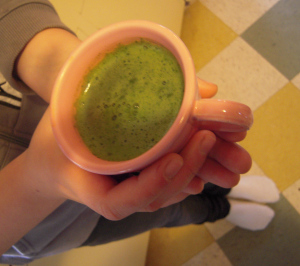
There is a lot of news these days about the dread flu going around. I’m not here to parse myth from fact, but I do have a delicious soup recipe for you! There are many immune stimulating reasons to eat this soup and I hope you find it as calming to your fears as it is nourishing to your body!
It is not necessary to make your own soup stock, but I did, and I threw some things in there that are good for the immune system, so I will share them with you.
Veggie/Bone Broth:
- Onion cut into quarters (I don’t peel it because the peel is rich in a flavonoid called quercitin)
- Garlic: a handful (garlic and onions both enhance the activities of our white blood cells which fight viruses)
- celery: 4-8 stalks
- carrots: 3-6
- tomatoes: 4-5 (I used Romas)
- zucchini: one cut into chunks
- Mushrooms: Dried Shitake, Miatake, Reishi
- 2 bay leaves, small handful of peppercorns, fennel seed
- 6 slices of dried astragalus (an antiviral herb)
- 6 slices of dried burdock root ( a tonic)
- 6 slices of dried licorice root (an antiviral herb)
- small handful of kelp
- Bones from an animal that had a happy life (chicken, beef, pork)
- Splash of organic apple cider vinegar (helps pull the minerals from the bones into the broth)
Put all the vegetables, bones and herbs in a large stainless steel pot and cover with water. Bring to a boil, then turn down to a simmer for 12-48 hours. Strain solids out and discard. Pour broth into jars for storage. Freezes well.
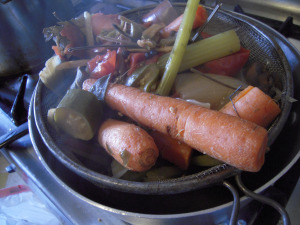
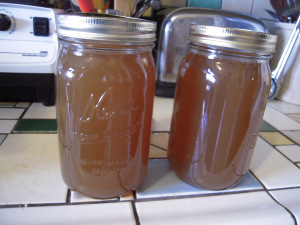
Now that you have your stock ready, or if you are using prepared stock, it just takes a few minutes to prepare the soup.
Greens, Garlic, Ginger Soup/ Flu Vaccine Soup
- 3 cups stock (veggie or chicken)
- 2 Tablespoons chopped fresh ginger
- 6 cloves fresh garlic (I have a stone that fits nicely into my hand that I use to smash garlic. Once smashed, the skin comes off easily.)
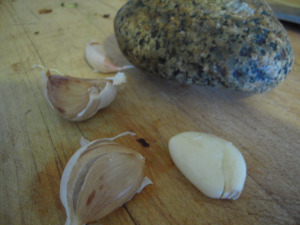
Bring to a boil and let the ginger and garlic simmer for 5-10 minutes in the broth.
- add 6-8 cups of chopped greens: kale, spinach, escarole, bok choy
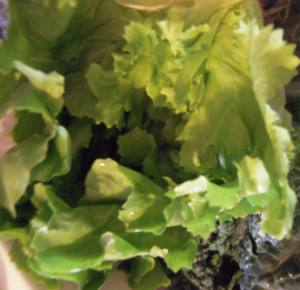
Let the greens cook for 5 minutes or so.
- add salt and pepper to taste
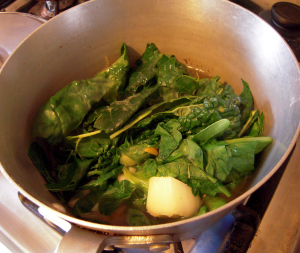
Blend in blender, food processor, or vita mix, until pureed.
Drink up!
Remember there are a few other simple things you can do to keep your immune system strong:
- Get adequate sleep
- Stay away from sugar and simple carbohydrates
- Get enough vitamin D
- Reduce your stress levels
- Laugh, love, and feel grateful everyday
- Wash your hands!
I ordered my dried herbs fromMountain Rose Herbs
Don't go without pumpkin pie this year! Gluten free, grain free, dairy free deliciousness!
I love my pumpkin pie, but I am determined this year to not have regrets about what I ate over the holidays! How many times do I need to learn that the recovery time is not really worth the few bites of gluten laden decadence? For those of you looking for a delicious alternative to feeling regret, read on! I started with a real pumpkin because my CSA gives them to me! But working with canned pumpkin is just fine too. The only thing is you won't have the yummy roasted pumpkin seeds to snack on while you are waiting for the pie to cool!
Start by baking a pumpkin, if that's your plan.
Scoop out the guts and seeds of the pumpkin.
Bake face down on a sheet pan at 350 degrees until soft. Let cool before scooping the flesh out of the shell into a measuring cup.
Meanwhile, separate the pumpkin guts from the pumpkin seeds. Rinse the seeds and roast with a little oil (I used delicious, nutritious coconut oil which I got here) until you hear popping sounds coming from the oven. They should be crunchy and irresistible, especially with good salt. Pumpkin seeds are a powerhouse of nutrition. Known to be a good source of minerals including zinc and magnesium as well as protein and essential fatty acids. Research suggests they are useful for prostate health, bone density, parasites, arthritis and healthy blood lipids. Find out more here.
In a food processor make the crust:
3/4 cup raw pecans or pumpkin seeds (grind ‘em up real good in the food processor)
1/4 cup ground flax seeds
1/2 cup coconut flour (find out why I'm such a fan of the coconut here and here)
1/2 tsp good salt
1/2 tsp cinnamon
1/3 cup coconut sugar
1/2 cup coconut oil
1 free range egg
Process dry stuff, add the coconut oil and process. Then add egg and pulse until it comes together. It will be sticky.
Press into a pie plate or tart pan. Freeze for 15-20 minutes, then bake for 20 minutes at 325 degrees until lightly browned.
Next mix up the filling in the food processor:
Filling:
1 1/2 cups pumpkin puree
3 eggs
1/4 cup coconut sugar
1/2 cup maple syrup (or less)
1/2 tsp good salt
1/4 tsp allspice
1 tsp freshly grated ginger
pinch of cayenne
pinch of ground cloves
1 can coconut milk (not LITE)
Blend everything together until it is a smooth puree. Pour into partially baked pie crust. Tap to release bubbles.
Bake 45-55 minutes at 325. Be sure to let it cool before you serve it.
Delicious ending to a healthy fall meal, but honestly it makes a darn good breakfast too!
Microbiome Back in Balance
Dr. Rose’s Perspective
The idea behind the SCD is that we want to eliminate the foods that the bacteria thrive on which consist of carbohydrates including starch (grains, beans, starchy vegetables), soluble fiber (grains, beans, vegetables, fruit), prebiotics (often added to your probiotic supplements as “food for the bacteria”, look for inulin, FOS), sugars (fruit, all added sweeteners). While this list may seem prohibitively restrictive, as Kristy has shared it IS possible to eat beautiful, delicious, fulfilling meals with COMPANY! Possibly 80% of IBS sufferers really have SIBO. Read more research HERE. Wouldn’t you rather know what you can do about it? In my experience if you have SIBO you will need antibiotics or herbs to eradicate the problem bacteria along with modifying your diet. Also important is looking to find the cause of the imbalance to begin with: motility problems related to nerve damage or medications, gastroenteritis, diabetes. We are learning more every day about the connection between our micro-biome and our health: immune health, mental health, digestive health. Using food to influence the balance of bacteria in our system is one way that we can influence every cell in our body!
Where I am Now (Kristy's update)
I am now SIBO free! While I’m extremely grateful and excited about this, I also realize there’s continual work and maintenance to be done. I receive weekly hydrotherapy sessions from Dr. Rose that will have a positive effect on my general gut motility and the vagus nerve specifically (instrumental in gut health). I’m follow a loose SCD, which means I generally avoid grains, heavy starches, lactose and sugar but can still go to a restaurant and not ask a waiter a million questions - fantastic! I’ve begun to add a bigger repetoire of fruits and vegetables back into my diet. Some of this is trial and error and I’m trying to balance my new found freedom with the knowledge that I am still healing and may always have a somewhat sensitive system. My journey has been a mixture of learning, healing, and becoming a key advocate of my health. I am grateful to be on this journey with several brilliant and caring doctors, Louise Rose being one of the most instrumental. Her natural curiosity and scientific knowledge mixed with empathy and compassion have supported me in both my physical and emotional well being. And lucky for me, she isn’t just a SIBO specialist but she also focuses on general health so we’ll be able to continue to work on my wellness together.
Thank you Kristy, for introducing my patients to this area of new research and sharing your personal story. I'm sure so many people can relate to your experiences!
Specific Carbohydrate Diet for SIBO
The Specific Carbohydrate Diet & a Major Lifestyle Change
More by Guest Blogger Kristy Regan, candidate for Masters of Science in Nutrition.
I was highly motivated to begin the new diet (SCD) immediately as I hated being sick. My friends were surprised that I would so easily give up the foods I loved. I can’t tell you how many times people have said to me, “Oh, I would just die if I couldn’t eat croissants/ice cream/insert favorite food here.” But for me, it was part of choosing health and wanting to feel whole again. And even though I found SCD very challenging it taught me immense amounts about food related symptoms and how I process specific foods. Over time, I learned that I can still prepare beautiful meals for family and friends that are also healthy and extremely enjoyable for me.
Here’s my list of SCD Frequently Asked Questions:
I’ve never been good at diets. How do I know this will work for me?
For most people, SCD becomes less of a short-term diet and more of a life style change. It can be an integral part of the healing process, easing IBS and inflammatory symptoms. Many people who have been on SCD long term say they feel much better and have more energy.
Which individual foods can I eat on the SCD Intro diet?
Homemade chicken broth, beef broth, carrots, roasted chicken, roasted turkey (no additives/no lunch meat), roasted lean pork (such as tenderloin), broiled fish,
beef broth, broiled hamburger, eggs, dry curd cottage cheese, 24 hour homemade yogurt, honey (small amounts), gelatin/homemade jello made with Welch's grape juice
(100% grape in a jar, any color, not frozen, not with calcium) or apple cider (cider only; commercial apple juice is not legal).
My symptoms aren’t out of control - can I skip the intro diet and just go to the regular diet?
No, for the diet to work, the introduction diet must be followed for two days minimum and five days maximum.
How do I know when I can add new foods and at what intervals?
After the introduction diet, and when cramping or diarrhea aren’t present, peeled and cooked fruit, ripe spotted bananas and peeled and cooked vegetables can be added to the diet.
Foods should be introduced one at a time, with a two to four day interval between new foods.
An entire list of legal/illegal founds can be found here
I don’t have time to make coconut milk, yogurt, etc. – why can’t I just buy them at the grocery store?
You must make or buy food where ALL ingredients are listed. Labeling in the US dictates that if less than 2% of an ingredient is included, it doesn’t need to be listed. Often unlisted ingredients include sugar or starch that isn’t allowed on SCD. Most commercial brands of coconut or almond milk contain starches and sugars. Label reading is particularly important because products may include sugar or starch products that you’re unfamiliar with. Refer to the legal/illegal list
Cooking becomes easier once you get used to making specific items. If you don’t have time to cook, it’s possible to buy some SCD legal foods.
Some SCD legal food websites: Wellbees SCD Bakery JK Gourmet
Is it ok if I cheat once a week or with just one food?
No, SCD isn’t like other diets where a little cheating is ok. Since bacteria are so small, a little bit of the wrong food will allow them to thrive and multiply.
That said it’s important to talk to your doctor about the diet in conjunction with antibiotics or other methods of healing. Most doctors believe the diet is meant to control the symptoms of SIBO but that it won’t necessarily “starve” the bacteria.
After two years of following the SCD fanatically, one of my doctors recommended I try following a “loose” SCD, so it really depends on your specific situation.
My family is worried about me because I’m rapidly losing weight and they think the diet is crazy.
Some people will lose weight because they have malabsorption or other issues. Some may initially lose weight because SCD entails a way of eating is very different than their previous lifestyle. SCD should be undertaken under the guidance of a doctor and/or a nutritionist. A medical professional will be able to recommend high calorie and/or high fat items that can be added to the diet to maintain weight.
I’m on the diet but I’m still having IBS symptoms. Should I give up?
No! It’s very helpful to keep a food and symptoms diary while you’re on the diet. There may be foods that were introduced too quickly or that are not tolerable. Keeping a food and symptom diary can help you and your doctor see trends in what you’re eating and your symptoms. If food isn’t tolerated, it can be removed and reintroduced after a month.
High FODMAPs foods are sometimes an issue for people. FODMAPs information can be found here:
I’m so frustrated about not going out with my friends/family to restaurants and parties.
Parties: If you know the host/hostess, it can be helpful to bring some of your own food and put it on a plate or out to share so you don’t have to feel like you’re not eating at all. It’s ok to drink small amounts of dry wine (no dessert wines). It’s good to eat before going to a party so you don’t feel deprived once you’re there. If you can afford the time and money, it’s often the most fun to have a party at your house. That way you can control the menu and serve only SCD friendly food. You can give friends SCD recipes to prepare or hire a caterer if possible so you don’t have to make everything by yourself.
Restaurants: It’s helpful to have a couple restaurants where you can develop relationships with the Chef and wait staff and feel respected and safe. Most chefs are used to dealing with special diets and would much rather get a phone call before a meal than to receive many special requests when they are in the middle of a busy service. If it’s a new restaurant, you can bring your own salad dressing or request lemon and olive oil. At most restaurants you will be able to order a basic protein and cooked vegetable side but be clear about no seasoning other than salt and pepper, no marinades, etc. Some people print out a laminated card that they can carry to restaurants that says what they can/can’t eat.
I’m torn between making traditional food for my family and staying on the diet for myself.
It’s challenging to be eating a different diet than the rest of your family. As you become more familiar with SCD recipes and your food variety increases, it becomes easier to make SCD legal food that everyone likes. Your health practitioner should be able to help you give family favorite recipes a “makeover” or introduce new recipes that can become traditional favorites.
It’s also important for your entire family to understand how very crucial it is for you to stay on the SCD diet. If you’re not well, you won’t be able to support your family and your current medical issues may become much more serious.
Stay tuned to hear more from Kristy about how she is doing!
Small Intestinal Bacterial Overgrowth-What is it?
Hi, I’m Kristy, a 45-year-old back-to-school student, earning my Master’s of Science in Nutrition. Dr. Rose has been kind enough to invite me to write a series of guest blog posts, talking about SIBO from a patient perspective. Dr. Rose will chime in with more information and her thoughts.
What is SIBO?
SIBO stands for small intestine bacterial overgrowth. Bacteria from the large intestine can migrate to the small intestine where it wreaks havoc on the overall system. Some signs of SIBO can include bloating, gassiness, constipation, diarrhea, fat malabsorption, abdominal cramping, fatigue, anxiety, leaky gut/food intolerances and acid reflux. My symptoms of gas, constipation, and eventually diarrhea started out as minor inconveniences and worsened over a couple of years before I understood I needed to see a doctor. I was covered by Kaiser but was worried that a MD would only prescribe medication to cover up my symptoms, or give me a diagnosis of IBS with no real solution. I decided to see a Naturopathic Doctor (ND) as NDs are trained to treat the whole person and to ascertain the root cause of symptoms. The ND I initially saw in Northern California first advised me to remove gluten and dairy from my diet as these are common food allergens which can cause IBS symptoms. When my symptoms continued to get worse, she tested me for SIBO. The SIBO test checks for hydrogen and methane gas that are specifically produced by an overgrowth of bacteria. I tested positive for SIBO. Upon hearing my diagnosis and the prescribed diet, I was angry, frustrated and sad. I considered myself a gourmand, the person who loves beautiful food, adores cooking with and for other people and cherishes communities who come together to share food around a table. The trial of giving up dairy and gluten had been very challenging for me but it was only a taste of was yet to come.
My ND recommended that I immediately start the introduction portion of the Specific Carbohydrate Diet (SCD). As a student on a very limited budget, I kept in contact with my doctor via email but didn’t have regular appointments until I moved to Portland for graduate school and found Dr. Rose and my GI doctor. Looking back, I wish I had done more research on SIBO treatments and also seen a ND or nutrition counselor regularly in the beginning as having SIBO had many physical, social and mental implications for me. (Click HERE to learn more about associated symptoms) I got frustrated navigating my symptoms, cried at more than one restaurant when I couldn’t find anything to eat or was served something other than what I had specifically asked for, worried about malabsorption, had issues concentrating and experienced anxiety and isolation. I now understand these are all SIBO related but I wish I had found Dr. Rose sooner as she’s played an integral role in educating and supporting me on the road to healing.
Stay tuned for another blog post by Kristy Regan about her path to wellness!













